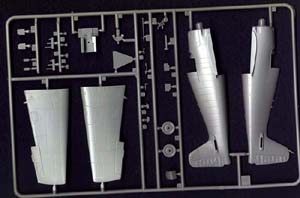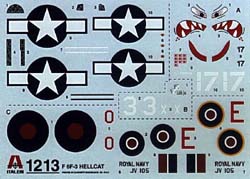Italeri’s 1/72 F6F-3 Hellcat
By Chris Bucholtz
 |

 |
 Modelers have long lamented the lack of a really accurate, state-of-the-art Spitfire in 1/72; the same argument can be made for the Hellcat. When Italeri’s kit arrived at my local hobby shop, I was in the process of kitbashing the Hasegawa and Academy kits. The Italeri kit solves one of the thornier problems, but introduces a host of new ones.
Modelers have long lamented the lack of a really accurate, state-of-the-art Spitfire in 1/72; the same argument can be made for the Hellcat. When Italeri’s kit arrived at my local hobby shop, I was in the process of kitbashing the Hasegawa and Academy kits. The Italeri kit solves one of the thornier problems, but introduces a host of new ones. If the control surfaces are the weak points, the treatment of the wheel wells and flaps are the strong points. The wheel wells are boxed in, except for at the rear. The rear of the wells was made up by the leading edge of the flaps, and Italeri cleverly provides dropped flaps, a first in any scale. Some of the scribing, like the shell ejection chutes, is a little weak, but in exchange the rocket rail holes are flashed over, unlike the Academy offering. Also unlike the Academy kit, there are no bomb racks provided.
If the control surfaces are the weak points, the treatment of the wheel wells and flaps are the strong points. The wheel wells are boxed in, except for at the rear. The rear of the wells was made up by the leading edge of the flaps, and Italeri cleverly provides dropped flaps, a first in any scale. Some of the scribing, like the shell ejection chutes, is a little weak, but in exchange the rocket rail holes are flashed over, unlike the Academy offering. Also unlike the Academy kit, there are no bomb racks provided. Decals are provided for three schemes: A U.S.S. Princeton-based VF-27 machine with the familiar snarling mouth in the markings of LT Richard Stambook (although the decal provided calls him “F.LT Stambook,” as if he had been shanghaied by the RAF); a second three-tone aircraft in the colors of U.S.S. San Jacinto’s VF-51, which carries nose art identifying it as “Little Joe;” and the Hellcat of LCDR Stanley G. Orr of 804 Squadron on H.M.S. Emperor, which is finished in the standard Royal Navy scheme of slate gray and dark sea gray over sky, although the box calls out European Green, Flat Gull Gray and Pale Green! Any modeler following these instructions will end up with a very weird looking Hellcat! The patterns shown for the three-tone scheme are also way off. To Italeri’s credit, the roundel red and the VF-27 markings are in different shades.
Decals are provided for three schemes: A U.S.S. Princeton-based VF-27 machine with the familiar snarling mouth in the markings of LT Richard Stambook (although the decal provided calls him “F.LT Stambook,” as if he had been shanghaied by the RAF); a second three-tone aircraft in the colors of U.S.S. San Jacinto’s VF-51, which carries nose art identifying it as “Little Joe;” and the Hellcat of LCDR Stanley G. Orr of 804 Squadron on H.M.S. Emperor, which is finished in the standard Royal Navy scheme of slate gray and dark sea gray over sky, although the box calls out European Green, Flat Gull Gray and Pale Green! Any modeler following these instructions will end up with a very weird looking Hellcat! The patterns shown for the three-tone scheme are also way off. To Italeri’s credit, the roundel red and the VF-27 markings are in different shades.